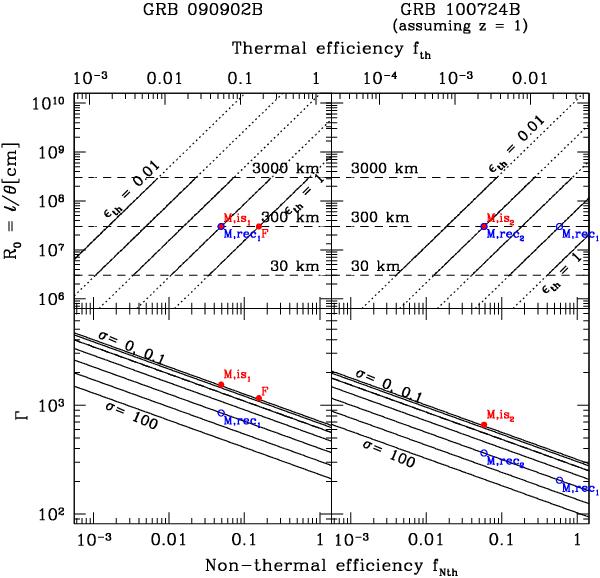Fig. 5

Constraints on the thermal and non-thermal emission in GRB 090902B and GRB 100724B. Top: for a given thermal fraction ϵth = 10-2, 10-1.5, 10-1, 10-0.5, and 1, the radius R0 = ℓ/θ at the base of the flow is plotted as a function of the non-thermal efficiency fNth. The corresponding thermal efficiency fth is also shown (top x-axis). Bottom: for a given magnetisation σ = 10-1, 10-0.5, 1, 100.5, 101, 101.5, and 102 at the end of acceleration phase, the Lorentz factor of the flow is plotted as a function of fNth (the unmagnetised case σ = 0 cannot be distinguished from the case σ = 0.1). Sets of parameters representative of the different classes of scenarios discussed in the paper are indicated: F (ϵth = 1, σ = 0) (standard fireball), M,is1 (log ϵth = −0.5, σ = 0,) and M,is2 (log ϵth = −1.5, σ = 0) (efficient magnetic acceleration: magnetisation is low above the photosphere and the dominant non-thermal mechanism is internal shocks), M,rec1 (log ϵth = −0.5, σ = 10), and M,rec2 (log ϵth = −1.5, σ = 10) (magnetised flow at large distance, the dominant non-thermal mechanism is magnetic reconnection). The initial radius is fixed to R0 = 300 km, a typical value for long GRBs. The observational data (thermal flux, temperature, ratio of the thermal over the total flux) used for the calculation (see text) are taken from Abdo et al. (2009); Pe’er et al. (2012) for GRB 090902B (left column), and from Guiriec et al. (2011) for GRB 100724B (right column).
Current usage metrics show cumulative count of Article Views (full-text article views including HTML views, PDF and ePub downloads, according to the available data) and Abstracts Views on Vision4Press platform.
Data correspond to usage on the plateform after 2015. The current usage metrics is available 48-96 hours after online publication and is updated daily on week days.
Initial download of the metrics may take a while.


